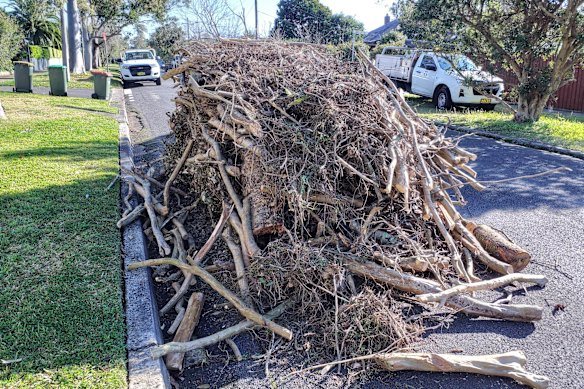Miller said the NSW government’s controversial waste levy – a per-tonne tax imposed on councils and waste facilities for disposing materials in landfill, passed on to the public in fees – may also be contributing to the scourge.
“The rising cost of the waste levy has made taking rubbish to waste facilities more expensive and, in a cost-of-living crisis, people are looking at saving money wherever they can,” she said.
Waste dumped on a road in the Willoughby Council area.Credit: Willoughby Council
“That’s having a big financial [impact] on councils because we’re not only having to pay the waste levy but also having to cover the cost of removing illegal rubbish, which means less money we’re able to spend on the core services our residents expect.”
Figures from the NSW Environment Protection Authority (EPA) show that illegal dumping is increasing not only on public land but also at privately owned sites. The watchdog issued 45 clean-up orders since January for landowners to clean up illegal material on private land.
Among the latest was a clean-up notice issued to a Sydney Animal Memorial Cemetery and Crematorium in Berkshire Park, where the EPA claims to have found 6000 tonnes of building and demolition waste.
Cemetery owner Shane McGraw said he was “not aware” of how the material came to be left on the site but said the business was complying with the EPA order to clean up the material.

Illegal waste dumped in the Campbelltown Council region.Credit: Campbelltown Council
Northern Beaches mayor Sue Heins said illegal dumping was a growing concern in residential areas, as it had the potential to cause “environmental damage” and “obstruct pedestrian access”.
Heins said the council’s measures to crack down on offending included targeted education campaigns and enforcement patrols by rangers.
In their own fights against illegal dumping, Parramatta, Ryde, Camden, Campbelltown and Sutherland councils are using mobile CCTV cameras to patrol hotspot areas for offending.
Lane Cove Council takes forensic analysis of illegally dumped material to identify offenders. Camden Council has resorted to erecting barriers around some council-owned sites to restrict public access, while Randwick Council plans to install garden beds on some nature strips identified as illegal dumping hotspots in Coogee.
Illegally dumped building waste is a common problem for Georges River Council, which supplied this photo. Credit: Georges River Council
Other council measures include public signage and increased lighting in public areas to deter offenders dumping items under the cover of darkness.
A Georges River Council spokeswoman said areas around unit complexes were disproportionately affected by illegal dumping due to the high turnover of tenants and “the anonymity such environments can provide to offenders”.
Fairfield Mayor Frank Carbone urged the NSW government to consider increasing fines for offences above the current cap of $16,000 for individuals.
“The penalties need to be reflective of the crime, and quite simply, $16,000 is not enough when it comes to illegal dumping, especially construction material and asbestos, which is not only costly for councils to clean up but also public health hazard,” he said.
Start the day with a summary of the day’s most important and interesting stories, analysis and insights. Sign up for our Morning Edition newsletter.
Read the full article here
